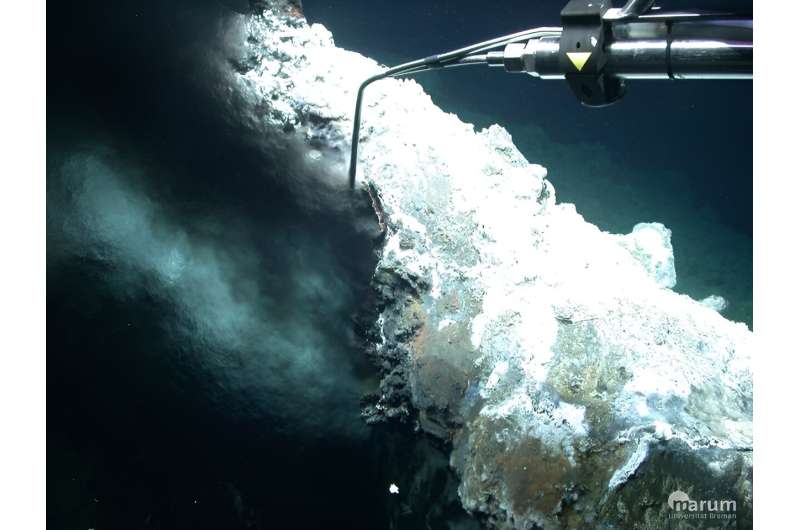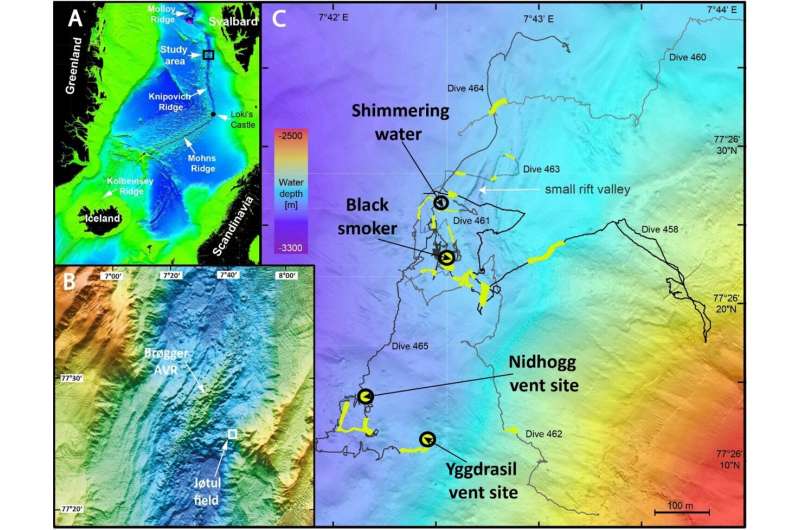
Temperature measurement at the outlet opening of the black smokehouse revealed fluid temperatures in excess of 300°C. Credit: University of Bremen
Hydrothermal vents are present all over the world, at the junctions of drifting tectonic plates. But many hydrothermal fields remain to be discovered. In 2022, during an expedition by the MARIA S. MERIAN, the first hydrothermal vent field was discovered on the 500-kilometer-long Knipovich Ridge off the coast of Svalbard.
An international team of researchers from Bremen and Norway, led by Professor Gerhard Bohrmann from MARUM – Center for Marine Environmental Science and the Department of Geosciences at the University of Bremen, reports this discovery today in the journal Scientific reports.
Hydrothermal vents are seeps on the sea floor from which hot liquids escape. “The water sinks to the ocean floor where it is heated by magma. The superheated water then rises to the sea floor through cracks and crevices. During its ascent, the fluid is enriched with minerals and materials dissolved in the rocks of the oceanic crust. These fluids often escape to the sea floor through tubular chimneys called “black smokers”, where metal-rich minerals are then precipitated,” explains Professor Gerhard Bohrmann from MARUM and chief scientist of the MARIA S expedition. MERIAN (MSM 109).
At a depth of more than 3,000 meters, the remotely operated submersible MARUM-QUEST collected samples from the newly discovered hydrothermal field. Named after Jøtul, a giant from Norse mythology, the field is located on the 500-kilometer-long Knipovich Ridge.
The ridge is located in the triangle formed by Greenland, Norway and Svalbard, on the border of the North American and European tectonic plates. This type of plate boundary, where two plates move apart, is called an expansion ridge.
The Jøtul field is located on an extremely slow spreading ridge with a plate growth rate of less than two centimeters per year. As very little is known about hydrothermal activity on slowly spreading ridges, the expedition focused on gaining insight into the escaping fluids, as well as the size and composition active and inactive smokers in the field.

(A) Map of the Norwegian Sea and Greenland (GEBCO data) with the location of active spreading centers on the seafloor and the study area. (B) Detailed map of the study area (onboard multibeam data acquired during the MSM109 cruise), including the Brøgger Axial Volcanic Ridge (AVR) and the newly discovered active hydrothermal zone called the Jøtul hydrothermal field. (C) AUV-based bathymetry of the Jøtul hydrothermal field (data acquired during the MSM109 cruise and provided by the Norwegian Offshore Directorate). Track lines from ROV dives are shown and portions of the track, where hydrothermal activity was visually observed, are marked in yellow. Four sites were sampled for fluids during MSM109 and are indicated by circles. Credit: Scientific reports (2024). DOI: 10.1038/s41598-024-60802-3
“The Jøtul field is a discovery of scientific interest not only because of its location in the ocean, but also because of its climatic significance, which was revealed, among other things, by our detection of very high methane concentrations in fluid samples,” reports Gerhard Bohrmann.
Methane emissions from hydrothermal vents indicate vigorous interaction of magma with sediments. As it travels through the water column, a large part of the methane is transformed into carbon dioxide, which increases the concentration of CO2 in the ocean and contributes to acidification, but it also impacts climate when it interacts with the atmosphere.
How much methane from the Jøtul field eventually escapes directly into the atmosphere, where it then acts as a greenhouse gas, still needs to be studied in more detail. Little is also known about the organisms living by chemosynthesis in the Jøtul field. In the darkness of the deep ocean, where photosynthesis cannot take place, hydrothermal fluids form the basis for chemosynthesis, used by very specific organisms in symbiosis with bacteria.
In order to delve deeper into the relatively scarce information available on the Jøtul field, a new expedition of the MARIA S. MERIAN will begin in late summer this year under the leadership of Gerhard Bohrmann. The objective of the expedition is the exploration and sampling of previously unknown areas of the Jøtul field. Thanks to the extensive data from the Jøtul field, it will be possible to make comparisons with the few hydrothermal fields already known in the Arctic province, such as the Aurora field and Loki Castle.
The published study is part of the Bremen Cluster of Excellence “The Ocean Floor – Earth’s Unexplored Interface”, which explores complex processes on the seafloor and their impacts on the global climate. The Jøtul field will also play an important role as a future research object within the cluster.
More information:
Gerhard Bohrmann et al, Discovery of the first hydrothermal field along the 500 km long Knipovich Ridge off Svalbard (the Jøtul field), Scientific reports (2024). DOI: 10.1038/s41598-024-60802-3
Provided by the University of Bremen
Quote:Investigation of newly discovered hydrothermal vents at depths of 3,000 meters off Svalbard (2024, June 28) retrieved June 29, 2024 from https://phys.org/news/2024-06-newly-hydrothermal-vents -depths-meters.html
This document is subject to copyright. Apart from any fair dealing for the purpose of private study or research, no part may be reproduced without written permission. The content is provided for informational purposes only.